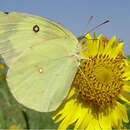Conservation Status
provided by University of Alberta Museums
Not of concern; a very rare stray.
- license
- cc-by-nc
- copyright
- University of Alberta Museums
Cyclicity
provided by University of Alberta Museums
Should be watched for in late summer (Bird et al. 1995).
- license
- cc-by-nc
- copyright
- University of Alberta Museums
Distribution
provided by University of Alberta Museums
Breeding resident throughout South and Central America north to the southernmost U.S., migrating and colonizing northward occasionally as far north as southern Canada (Opler 1999). The only Alberta specimen was collected by Art Rupp in Didsbury during the 1940s (Bird et al. 1995).
- license
- cc-by-nc
- copyright
- University of Alberta Museums
General Description
provided by University of Alberta Museums
The pattern of the black forewing border, resembling a dog's (poodle's?) face, is unmistakable. While flying, however, this species resembles the Common Sulphur (Colias philodice) (Nielsen 1999).
- license
- cc-by-nc
- copyright
- University of Alberta Museums
Habitat
provided by University of Alberta Museums
A rare stray in Alberta, most likely to be encountered in the southern third of the province.
- license
- cc-by-nc
- copyright
- University of Alberta Museums
Life Cycle
provided by University of Alberta Museums
The larvae are green or yellow with hairy, black tubercles and a combination of black and yellow stripes and / or black and yellow bands (Layberry et al. 1998). This species is not able to overwinter in Canada, and occurs only as a rare stray (Layberry et al. 1998).
- license
- cc-by-nc
- copyright
- University of Alberta Museums
Trophic Strategy
provided by University of Alberta Museums
Larvae feed on many species of legumes (Opler 1999).
- license
- cc-by-nc
- copyright
- University of Alberta Museums
Zerene cesonia
provided by wikipedia EN
Zerene cesonia, the southern dogface, is a North and South American butterfly in the family Pieridae, subfamily Coliadinae (until recently the species was sometimes placed in the related genus Colias instead of Zerene).
Description
The upper side of the pointed forewings have a dogface pattern. The wings are mainly yellow with black borders. The underside of the wings is mostly yellow with a black eyespot on the forewing and two white spots on the hindwing.
Ecology
This butterfly can be found in short-grass prairie hills, open woodlands, and near road edges.
Both male and female southern dogfaces may be seen feeding at flowers such as alfalfa, Coreopsis species, Houstonia species, and Verbena species. Males are also fond of puddling. Its host plants include the leadplant Amorpha canescens, false indigo Amorpha fruticosa, soybean Glycine max, alfalfa Medicago sativa, black dalea Dalea frutescens, purple prairie clover Dalea purpurea, and clover Trifolium species.
Males patrol areas for females. The male is the active flight partner.
The green-white eggs are laid on the underside of the host plant leaves. The larva is green with a white stripe running down each side of its body. The green chrysalis hangs upright with a silken girdle around itself.
References

- license
- cc-by-sa-3.0
- copyright
- Wikipedia authors and editors
Zerene cesonia: Brief Summary
provided by wikipedia EN
Zerene cesonia, the southern dogface, is a North and South American butterfly in the family Pieridae, subfamily Coliadinae (until recently the species was sometimes placed in the related genus Colias instead of Zerene).
- license
- cc-by-sa-3.0
- copyright
- Wikipedia authors and editors

